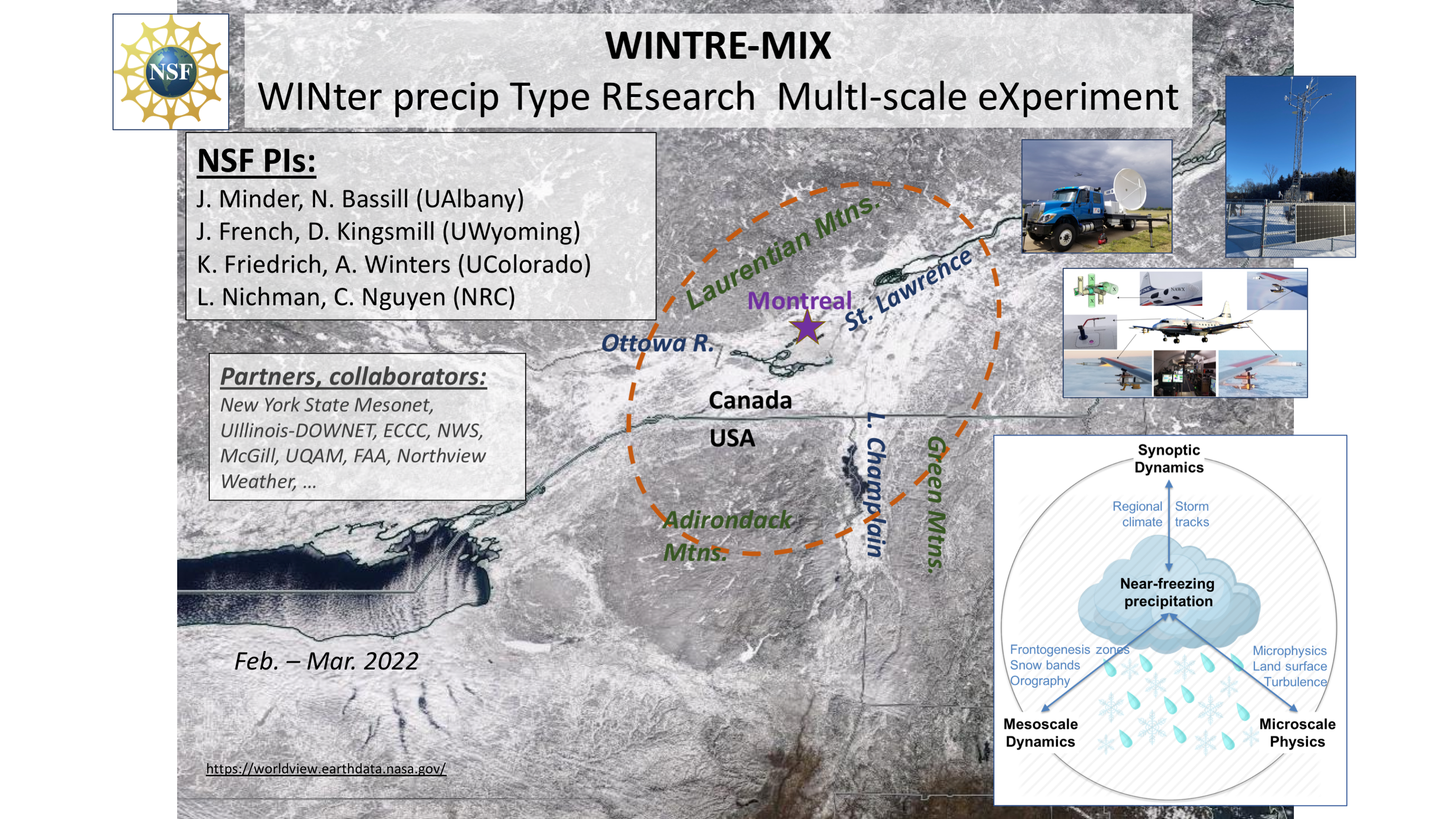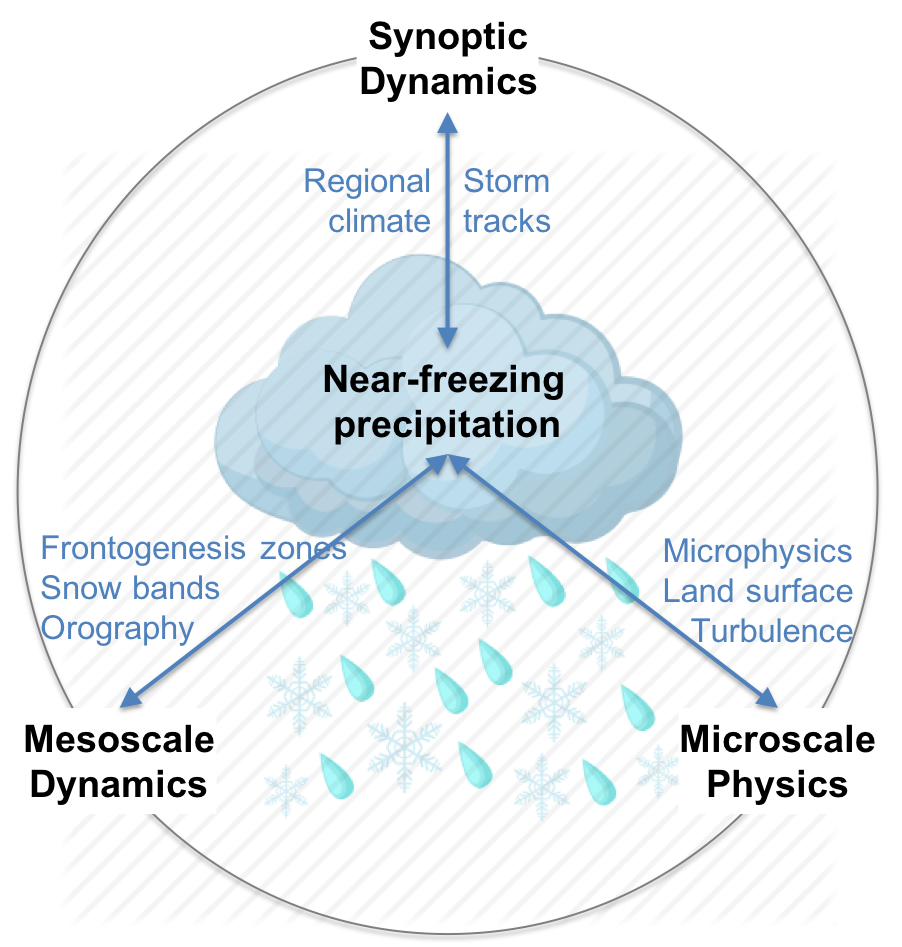WINTRE-MIX
WINTRE-MIX: Winter Precipitation Type Research Multi-scale Experiment
Overview
During near-freezing surface conditions, a diversity of surface precipitation types (p-types) are possible, including: rain, drizzle, freezing rain, freezing drizzle, wet snow, ice pellets, and snow. Such near-freezing precipitation affects wide swaths of the United States and Canada, impacting aviation, road transportation, power generation and distribution, winter recreation, ecology, and hydrology. These events are shaped by diverse synoptic, mesoscale, and microscale processes, and are expected to change as the weather warms. Fundamental challenges remain in our ability to adequately observe, diagnose, simulate, and forecast them, especially when dealing with transitions between p-types and regions of complex terrain.
To address these challenges, we propose to conduct the Winter Precipitation Type Research Multi-scale Experiment (WINTRE-MIX) with the overarching goal to better understand how multi-scale processes influence the variability and predictability of p-type and amount under near-freezing surface conditions. The experiment will be conducted near Montreal, Canada during February - March 2022. The study region has a strong backbone of existing state-of-the-art mesoscale observation networks, and experiences plentiful near-freezing precipitation with interesting terrain influences. WINTRE-MIX will supplement existing networks with additional observations from aircraft, mobile radars, and other surface- based instruments. Major facilities to be deployed are the National Research Council (NRC) Convair-580 aircraft with in-situ and remote sensing capabilities, and three mobile Doppler on Wheels dual- polarization radars (C- and X-band). WINTRE-MIX field activities will benefit from collaborative efforts by partners including: Canadian academic institutions, Environment Climate Change Canada, the Federal Aviation Administration, the National Weather Service, and the private company Northview Weather. The comprehensive dataset generated will depict these events in unprecedented detail, as such events have not been the focus of a major field campaign in recent decades.
Intellectual merit
This research will make fundamental contributions to the fields of cloud and precipitation microphysics, numerical modeling and forecasting, radar meteorology, boundary layer meteorology, and mountain meteorology. It will address the following basic questions: (1) How do mesoscale dynamics (especially terrain-modified flows) modulate near-freezing precipitation? (2) How do microscale processes modulate near-freezing precipitation? (3) How do multi-scale processes combine to determine the predictability of near-freezing precipitation?
Broader impacts
The research will contribute to broader impacts in three areas: (1) improving forecasts of near- freezing precipitation through forecast model evaluation, model physics and data assimilation improvements, improvement of radar retrievals, and improvements to aviation icing diagnostics, (2) improved communication between researchers, forecasters, and stakeholders (e.g., National Grid, the New York State Department of Transportation) through the facilitation of two workshops and collaborative partnerships, and (3) improved scientific training, literacy, and engagement through education of undergraduate and graduate students, postdoc mentoring, educational outreach events, and citizen science observations.
Collaborators and Partners
- University of Québec at Montréal –UQAM (Julie Theriault)
- McGill University (John Gyakum, Frederic Fabry, Dan Kirshbaum)
- Environment and Climate Change Canada – ECCC (Ishmail Gultepe, Daniel Michelson)
- National Weather Service – NWS
- Northview Weather (Jason Shafer)
- FAA-TAIWIN demonstration project (Stephanie DiVito)
- NASA-IMPACTS project (Lynn McMurdie)
Principal Investigators
Justin Minder (Lead) U Albany
Nick Bassill U Albany
Cuong Nguyen NRC
Leonid Nichman NRC
Katja Friedrich U Colorado Boulder
Andrew Winters U Colorado Boulder
David Kingsmill U Wyoming
Jeffrey R. French U Wyoming
Data Manager
EOL Archive NCAR/EOL/DMS

